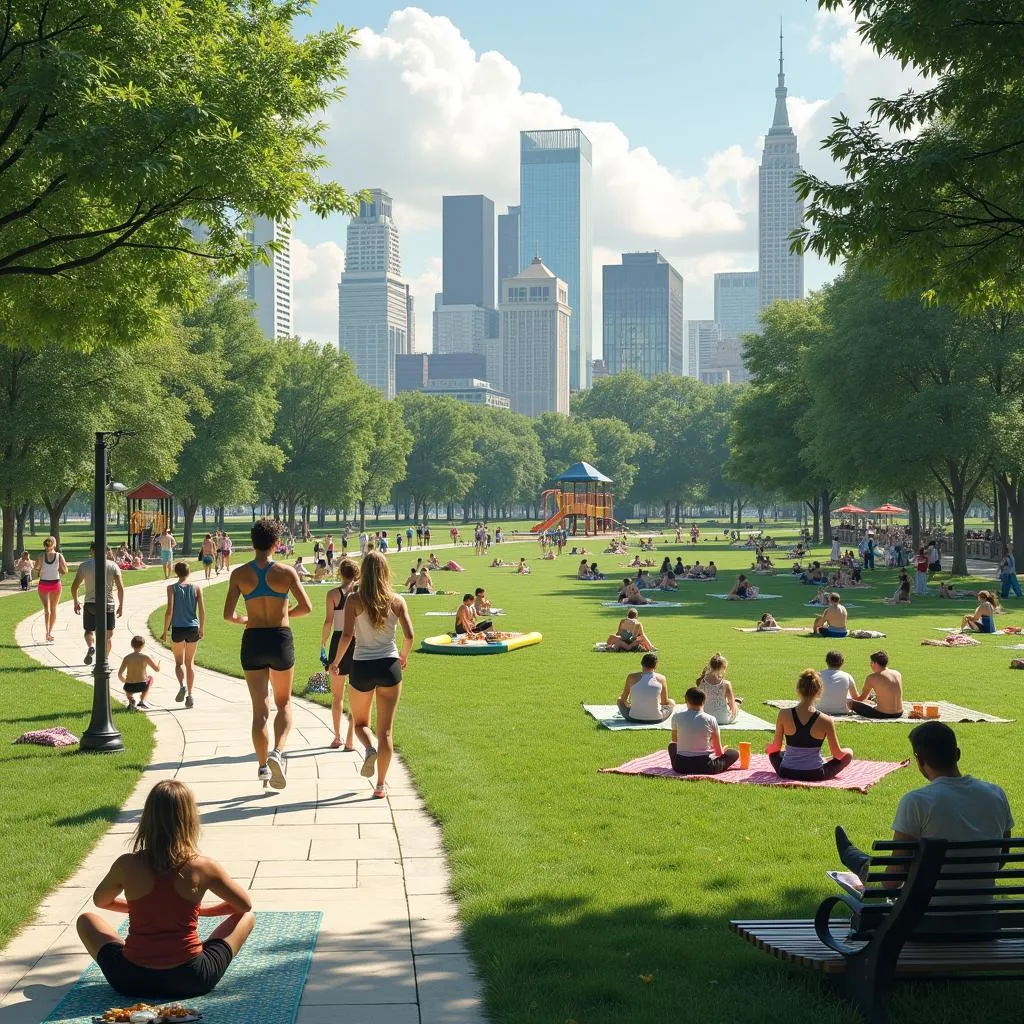The topic of describing a park in your city where you enjoy spending time is a popular one in IELTS Speaking tests. It allows examiners to assess candidates’ ability to discuss familiar places and express personal preferences. This theme has appeared frequently in past exams and is likely to continue being a common topic in future IELTS Speaking tests.
Nội dung bài viết
- Part 1: Introduction and Interview
- Do you often visit parks?
- What activities do people usually do in parks?
- Are there many parks in your city?
- Part 2: Long Turn
- Cue Card
- Sample Answer (Band 8-9)
- Follow-up Questions
- Part 3: Two-way Discussion
- How do parks contribute to the quality of life in cities?
- How can city planners balance the need for green spaces with the demand for housing and commercial development?
- Key Vocabulary and Phrases for High Scores
- Examiner’s Advice
Part 1: Introduction and Interview
In this section, the examiner may ask general questions about parks and outdoor spaces. Here are some potential questions with sample answers:
Do you often visit parks?
Band 6-7 Answer:
Yes, I do. I try to visit parks at least once a week, usually on weekends. It’s a nice way to relax and get some fresh air.
Band 8-9 Answer:
Absolutely! I make it a point to frequent parks regularly, typically two to three times a week. I find that immersing myself in nature is not only a fantastic way to unwind but also an essential part of maintaining my physical and mental well-being.
What activities do people usually do in parks?
Band 6-7 Answer:
People do many things in parks. They often exercise, have picnics, or play games with friends and family. Some people also read books or just relax on the grass.
Band 8-9 Answer:
Parks offer a diverse range of activities catering to various interests. Many individuals engage in physical pursuits such as jogging, yoga, or team sports. Families often use parks for social gatherings and picnics, while others seek out these green spaces for more contemplative activities like reading, sketching, or simply basking in the tranquility of nature. Additionally, parks serve as venues for community events and outdoor concerts, fostering a sense of local community.
 Diverse range of activities in a city park
Diverse range of activities in a city park
Are there many parks in your city?
Band 6-7 Answer:
Yes, there are quite a few parks in my city. We have some big ones in the center and smaller ones in residential areas. They’re pretty popular, especially on weekends.
Band 8-9 Answer:
Indeed, my city boasts a substantial number of parks, ranging from expansive urban green spaces in the heart of the city to more intimate neighborhood parks. The local government has made a concerted effort to integrate green areas into urban planning, recognizing their importance for residents’ quality of life. These parks form a vital network of green infrastructure, providing numerous environmental and social benefits to our community.
Part 2: Long Turn
In this section, you’ll be given a cue card with a topic to speak about for 1-2 minutes. Here’s a sample cue card related to describing a park:
Cue Card
Describe a park in your city where you enjoy spending time.
You should say:
- Where it is located
- What features it has
- What activities you can do there
- And explain why you enjoy spending time in this park
Sample Answer (Band 8-9)
I’d like to talk about Central Park, a magnificent urban oasis located in the heart of my city. This sprawling green space spans several blocks and serves as a vital breathing space amidst the hustle and bustle of urban life.
One of the park’s most striking features is its meticulously landscaped gardens, which showcase a diverse array of flora, from vibrant flowerbeds to majestic old-growth trees. The park also boasts a picturesque lake at its center, complete with charming bridges and a boathouse, offering visitors the opportunity to rent paddleboats or simply enjoy the serene water views.
The park caters to a wide range of activities, making it a versatile recreational space. There are well-maintained walking and jogging trails that wind through the park, perfect for fitness enthusiasts. For sports lovers, there are tennis courts, basketball courts, and open fields ideal for soccer or frisbee. Families with children can enjoy the state-of-the-art playground equipment and the delightful mini-zoo that houses a variety of small animals.
I find myself drawn to this park time and time again because it offers a perfect escape from the concrete jungle. The moment I step into the park, I’m enveloped by a sense of tranquility. The lush greenery and the sound of rustling leaves have a profoundly calming effect on me. Moreover, the park’s diverse offerings mean that each visit can be a unique experience, whether I’m in the mood for a vigorous workout, a leisurely stroll, or simply finding a quiet spot to read a book.
In essence, this park is more than just a green space; it’s a vital community hub that brings people together and provides a much-needed connection to nature in our urban environment. It’s a place where I can recharge, reflect, and reconnect with both nature and my community, making it an invaluable part of my city life.
 Central Park: An urban oasis in the city
Central Park: An urban oasis in the city
Follow-up Questions
- How has the park changed over the years?
Band 6-7 Answer:
The park has seen some changes over time. They’ve added new play equipment for kids and improved the walking paths. There are also more events held in the park now compared to before.
Band 8-9 Answer:
Over the years, the park has undergone a significant transformation. The local authorities have implemented a comprehensive renovation plan, which has led to several notable improvements. The landscaping has been enhanced with the introduction of more native plant species, promoting biodiversity and creating a more sustainable ecosystem. The recreational facilities have been modernized and expanded, including the addition of fitness stations along the jogging trails and the creation of a dedicated area for outdoor concerts and cultural events. Moreover, there’s been a concerted effort to make the park more inclusive and accessible, with improved pathways and facilities for people with disabilities.
- Do you think cities should invest more in public parks?
Band 6-7 Answer:
Yes, I think cities should invest more in parks. They’re important for people’s health and well-being. Parks give people places to exercise and relax, which is especially important in busy cities.
Band 8-9 Answer:
Absolutely, I’m a firm believer that cities should prioritize investment in public parks. These green spaces serve multiple crucial functions in urban environments. Firstly, they act as natural air purifiers, helping to mitigate air pollution and reduce the urban heat island effect. Secondly, parks provide essential habitats for urban wildlife, contributing to biodiversity conservation. From a social perspective, parks serve as democratic spaces that foster community interaction and social cohesion, transcending socioeconomic boundaries. They also offer myriad health benefits, both physical and mental, by providing spaces for exercise, relaxation, and stress relief. In an era of increasing urbanization, investing in high-quality public parks is not just desirable but imperative for creating livable, sustainable cities.
Part 3: Two-way Discussion
In this section, the examiner will ask more abstract questions related to the topic. Here are some potential questions with sample answers:
How do parks contribute to the quality of life in cities?
Band 6-7 Answer:
Parks are really important for city life. They give people places to relax and exercise, which is good for health. Parks also make cities look nicer and can be good for the environment. They’re especially important for people who live in apartments and don’t have their own gardens.
Band 8-9 Answer:
Parks play a multifaceted role in enhancing the quality of urban life. Firstly, they serve as vital green lungs for cities, helping to mitigate air pollution and regulate urban temperatures. This environmental function is increasingly critical in the face of climate change challenges.
Secondly, parks provide essential spaces for physical activity and recreation, which is paramount in promoting public health and combating the sedentary lifestyles often associated with urban living. They offer cost-free venues for exercise and sports, making healthy living more accessible to all socioeconomic groups.
Moreover, urban parks contribute significantly to mental well-being. They offer respite from the sensory overload of city life, providing spaces for relaxation, meditation, and stress relief. The exposure to nature, even in small doses, has been scientifically proven to reduce stress levels and improve overall mental health.
From a social perspective, parks act as community hubs, fostering social interaction and strengthening community bonds. They provide neutral grounds for people from diverse backgrounds to mingle, thereby promoting social cohesion and cultural exchange.
Lastly, well-maintained parks can enhance property values in surrounding areas and contribute to the overall aesthetic appeal of a city, making it more attractive to residents, tourists, and businesses alike. In essence, parks are not just amenities but vital components of urban infrastructure that significantly elevate the quality of life in cities.
 Urban park's multifaceted role in city life
Urban park's multifaceted role in city life
How can city planners balance the need for green spaces with the demand for housing and commercial development?
Band 6-7 Answer:
This is a difficult challenge for city planners. They need to find a good balance between green spaces and development. One way could be to include small parks in new housing projects. They could also create green roofs on buildings or vertical gardens. It’s important to have both development and green spaces in cities.
Band 8-9 Answer:
Balancing the need for green spaces with urban development demands a nuanced and innovative approach from city planners. It requires a paradigm shift from viewing parks as luxury add-ons to recognizing them as essential urban infrastructure.
One effective strategy is to integrate green spaces into development plans from the outset. This could involve mandating a certain percentage of green space in new developments, encouraging the creation of pocket parks in dense urban areas, or incorporating green corridors that connect larger parks and natural areas.
Vertical integration of green spaces is another innovative solution. This includes green roofs, living walls, and sky gardens in high-rise buildings. These not only provide green spaces but also offer environmental benefits such as improved air quality and energy efficiency.
Adaptive reuse of underutilized urban spaces, such as converting abandoned lots or defunct industrial areas into parks, can create new green spaces without impinging on areas earmarked for development.
Mixed-use development that combines residential, commercial, and green spaces can create more livable urban environments. This approach can lead to the development of urban villages where residents have easy access to both amenities and nature.
Implementing stringent zoning laws that protect existing green spaces and incentivize the creation of new ones in development projects is crucial. This could include offering density bonuses or tax incentives to developers who incorporate substantial green spaces in their projects.
Lastly, community engagement in the planning process is vital. Involving local residents in decisions about green spaces can lead to more effective and widely accepted urban planning solutions.
By adopting these multifaceted approaches, city planners can strive to create urban environments that are both economically vibrant and ecologically sustainable, enhancing the overall quality of urban life.
Key Vocabulary and Phrases for High Scores
-
Urban oasis [ˈɜːbən əʊˈeɪsɪs] (noun phrase): A pleasant or peaceful area in a busy city.
Example: Central Park serves as an urban oasis in the heart of New York City. -
Biodiversity [ˌbaɪəʊdaɪˈvɜːsəti] (noun): The variety of plant and animal life in a particular habitat.
Example: The park’s diverse ecosystem supports a rich biodiversity. -
Sustainable [səˈsteɪnəbl] (adjective): Able to be maintained at a certain rate or level.
Example: The park management has implemented sustainable practices to conserve water and energy. -
Revitalize [ˌriːˈvaɪtəlaɪz] (verb): To give new life or vigor to.
Example: The renovation project aims to revitalize the old city park. -
Tranquility [træŋˈkwɪləti] (noun): The quality or state of being calm.
Example: The park offers a sense of tranquility amidst the bustling city life.
 Key vocabulary for describing urban parks
Key vocabulary for describing urban parks
Examiner’s Advice
To achieve high scores in the IELTS Speaking test when describing a park or any other topic:
-
Develop your ideas fully: Don’t just give short, simple answers. Expand on your points with examples and explanations.
-
Use a range of vocabulary: Incorporate topic-specific vocabulary and more advanced words and phrases naturally in your responses.
-
Demonstrate grammatical range: Use a mix of simple and complex sentence structures. Show your ability to use different tenses and conditional forms where appropriate.
-
Maintain fluency: Practice speaking at length on various topics to improve your ability to speak continuously without long pauses.
-
Work on pronunciation: Focus on clear articulation and appropriate stress and intonation patterns.
-
Stay relevant: Always address the question asked and stay on topic.
-
Be specific: Use concrete details and personal experiences to make your answers more engaging and authentic.
Remember, regular practice and exposure to English through various media can significantly improve your speaking skills. Consider describing a nature reserve that you would like to visit or describe a recent visit to a park or garden to broaden your vocabulary and practice different aspects of describing outdoor spaces.
By incorporating these strategies and continuously working on your English skills, you’ll be well-prepared to excel in the IELTS Speaking test, particularly when discussing topics related to parks and urban green spaces.


